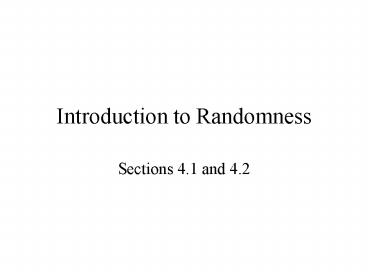Introduction to Randomness - PowerPoint PPT Presentation
1 / 15
Title:
Introduction to Randomness
Description:
Turn over the cards to reveal which babies were randomly assigned to which mothers. ... Where 1234 means each mom got right baby, And 1243 means the 3rd and 4th ... – PowerPoint PPT presentation
Number of Views:19
Avg rating:3.0/5.0
Title: Introduction to Randomness
1
Introduction to Randomness
- Sections 4.1 and 4.2
2
We said that it is very important to select your
sample randomly. (One reason is that this helps
to reduce bias.) At first glance it might seem
that introducing randomness into the process
would make it more difficult to draw reliable
conclusions. But we will see that randomness
produces patterns that allow us to quantify how
close properties of a sample will come to the
corresponding properties of the population. (This
is another reason why it is important to select
your samples randomly.)
3
Example
Suppose that one night at a certain hospital,
four mothers (named Lubbers, Maas, Peale, and
VanZoren) give birth to four baby boys. Each
mother gives her child a first name alliterative
to his last Larry Lubbers, Michael Maas, Peter
Peale, and Victor VanZoren. As a very silly
joke, the hospital staff decides to return babies
to their mothers completely at random.
4
Simulation
- Simulation is an artificial representation of a
random process used to study its long-term
properties. - Take four index cards and one sheet of scratch
paper. Write a babies name on each index card,
and divide the paper into four area with a
mothers last name written in each area. Shuffle
the four index cards well, and then deal them out
with one going to each area of the sheet. Turn
over the cards to reveal which babies were
randomly assigned to which mothers. - Individual Results
5
Proportion of exactly one match.
6
Two components of random behavior.
- Unpredictable in the short run.
- Regular and predictable pattern in long run.
7
Probability of any outcome of a random event
- is the proportion of times the outcome would
occur in a very long series of repetitions. - A probability can be approximated by simulating
the experiment many times. The approximated
probability is called an empirical probability. - The more repetitions used, the closer the closer
the empirical probability will generally be to
the probability.
8
Class results of Simulation
9
Probability Model/Distribution
- A list of all possible outcomes of the random
event (called the sample space) - A way of assigning probabilities to each outcome.
- The probability distribution is a list of all
possible outcomes along with the probability of
each.
10
Probability Model for Example
- The sample space is
- 1234 1243 1324 1342 1423 1432
- 2134 2143 2314 2341 2413 2431
- 3124 3142 3214 3241 3412 3421
- 4123 4132 4213 4231 4312 4321,
- Where 1234 means each mom got right baby,
- And 1243 means the 3rd and 4th babies were
switched - How many different arrangements are there for
returning the babies to the mothers? - Each of these different outcomes are equally
likely and should thus have probability ___.
11
Probabilities of Desired Events
- For each arrangement, indicate how many mothers
got the correct baby. - In how many arrangements is the number of matches
equal to exactly - 4 3 2 1 0
- Calculate the (exact) probabilities by dividing
your answers by the total number of arrangements. - 4 3 2 1 0
- This is the probability distribution.
12
- What does one of these probabilities mean?
(Remember the definition of probability.) - How close were our empirical probabilities to the
(exact) probabilities?
13
Basic Probability rules.
- The probability of any event is between 0 and 1
inclusive. - For any event A, P(A does not occur) 1-P(A)
Example 1 What is the probability that at least
one mother gets the correct baby? - Example 2 What is the probability that the
hospital gets sued? (Assume anyone who gets the
wrong baby sues the hospital.)
14
Notation
- Random Variable a variable whose value is a
numerical outcome of a random phenomenon. - Example X
- Probability statements.
- The probability that no mothers get their baby
back can be written - The probability that at least one mother gets
their baby back can be written - The probability that the hospital gets sued can
be written
15
Mean and Standard Deviation
- From Data
- The _____ data points we collected in class were
- _____ 0s, ____ 1s, ____ 2s, _____ 3s and
_____ 4s. - If we put that data in our calculator the mean is
- And the standard deviation of the data is
- The Mathematical model.
- The mean (µ) number of babies that will be given
to the correct mother is - The mathematical model has a standard deviation
denoted by s. For this model s 1































